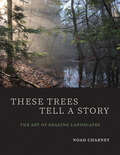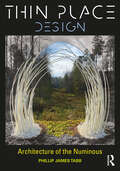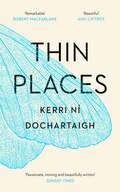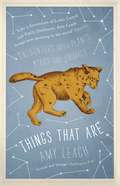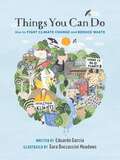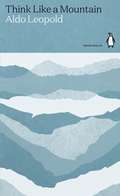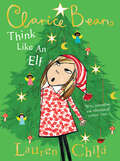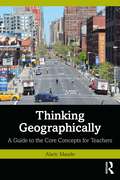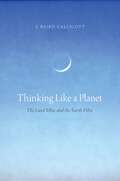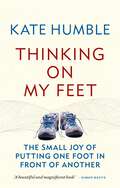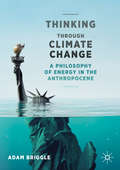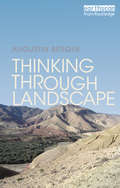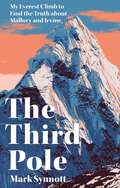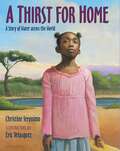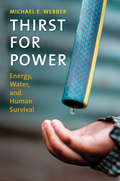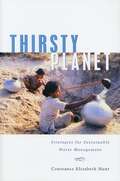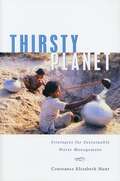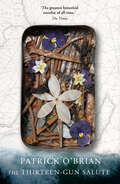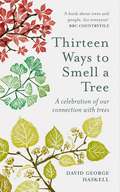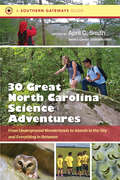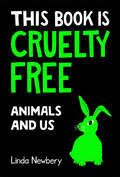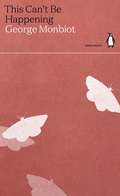- Table View
- List View
These Trees Tell a Story: The Art of Reading Landscapes
by Noah CharneyA deeply personal master class on how to read a natural landscape and unravel the clues to its unique ecological history Structured as a series of interactive field walks through ten New England ecosystems, this book challenges readers to see the world through the eyes of a trained naturalist. With guided questions, immersive photography, and a narrative approach, each chapter adds layers of complexity to a single scene, revealing the millions of years of forces at play. Tying together geology, forest ecology, wildlife biology, soil processes, evolution, conservation, and more, Noah Charney shows how and why landscapes appear in their current forms. Charney’s stories and lessons will provide anyone with the necessary investigative skills to look at a landscape, interpret it, and tell its story—from its start as rock or soil to the plants and animals that live on it. Ultimately, Charney argues, by critically engaging with the landscape we will become better at connecting with nature and ourselves.
Thin Place Design: Architecture of the Numinous
by Phillip James TabbWhat makes the places we inhabit extraordinary? Why are some urban spaces more vital and restorative? Wonderful landscapes, inspiring works of architecture and urban design, and the numinous experiences that accompany them have been an integral dimension of our culture. Up-lifting spaces, dramatic use of natural light, harmonic proportional geometry, magical landscapes, historic sites and vital city centers create special, even sacred moments in architecture and planning. This quality of experience is often seen as an aesthetic purpose intended to inspire, ennoble, ensoul and spiritually renew. Architecture and urban spaces, functioning in this way, are considered to be thin places.
Thin Place Design: Architecture of the Numinous
by Phillip James TabbWhat makes the places we inhabit extraordinary? Why are some urban spaces more vital and restorative? Wonderful landscapes, inspiring works of architecture and urban design, and the numinous experiences that accompany them have been an integral dimension of our culture. Up-lifting spaces, dramatic use of natural light, harmonic proportional geometry, magical landscapes, historic sites and vital city centers create special, even sacred moments in architecture and planning. This quality of experience is often seen as an aesthetic purpose intended to inspire, ennoble, ensoul and spiritually renew. Architecture and urban spaces, functioning in this way, are considered to be thin places.
Thin Places
by Kerri ni DochartaighA breathtaking mix of memoir, nature writing and history: this is Kerri ní Dochartaigh’s story of a wild Ireland, an invisible border, an old conflict and the healing power of the natural world 'A special, beautiful, many-faceted book' Amy Liptrot 'A remarkable piece of writing . . . Luminous' Robert Macfarlane Kerri ní Dochartaigh was born in Derry, on the border of the North and South of Ireland, at the very height of the Troubles. She was brought up on a council estate on the wrong side of town. But for her family, and many others, there was no right side. One parent was Catholic, the other was Protestant. In the space of one year they were forced out of two homes and when she was eleven a homemade petrol bomb was thrown through her bedroom window. Terror was in the very fabric of the city, and for families like Kerri’s, the ones who fell between the cracks of identity, it seemed there was no escape. In Thin Places, a mixture of memoir, history and nature writing, Kerri explores how nature kept her sane and helped her heal, how violence and poverty are never more than a stone’s throw from beauty and hope, and how we are, once again, allowing our borders to become hard, and terror to creep back in. Kerri asks us to reclaim our landscape through language and study, and remember that the land we fight over is much more than lines on a map. It will always be ours but, at the same time, it never really was.
Things That Are: Encounters with Plants, Stars and Animals
by Amy LeachFrom the tiniest Earth dwellers to far-flung celestial bodies - considering everything from the similarity of gods to donkeys, to exploding stars and exploding sea cucumbers - Amy Leach rekindles our communion with the world. This stunning debut will leave you with a deeper understanding of the universe and a greater sense of the magic that surrounds us.
Things You Can Do: How to Fight Climate Change and Reduce Waste
by Eduardo GarciaWhat if we could help to save our planet through small habit changes in our homes? Learn what you can do right now to live a greener life your carbon footprint with this inspiring, accessible, stunningly illustrated book based on Eduardo Garcia's popular New York Times column.Award-winning climate journalist Eduardo Garcia offers a deeply researched and user-friendly guide to the things we can do every day to fight climate change. Based on his popular New York Times column "One Thing You Can Do," this fully illustrated book proposes simple solutions for an overwhelming problem. No lectures here - just accessible and inspiring ideas to slash emissions and waste in our daily lives, with over 350 explanatory illustrations by talented painter Sara Boccaccini Meadows.In each chapter, Garcia digs into the issue, explaining how everyday choices lead to carbon emissions, then delivers a wealth of 'Things You Can Do' to make a positive impact, such as:- Eat a climate-friendly diet - Reduce food waste- Save energy at home- Adopt zero-waste practicesPrinted on environmentally-friendly paper and delivering a decisive hit of knowledge with every turn of the page, Things You Can Do is the book for people who want to know more - and do more - to save the planet.
Think Like a Mountain (Green Ideas)
by Aldo LeopoldIn twenty short books, Penguin brings you the classics of the environmental movement.In this lyrical meditation on America's wildlands, Aldo Leopold considers the different ways humans shape the natural landscape, and describes for the first time the far-reaching phenomenon now known as 'trophic cascades'.Over the past 75 years, a new canon has emerged. As life on Earth has become irrevocably altered by humans, visionary thinkers around the world have raised their voices to defend the planet, and affirm our place at the heart of its restoration. Their words have endured through the decades, becoming the classics of a movement. Together, these books show the richness of environmental thought, and point the way to a fairer, saner, greener world.
Think Like an Elf: Think Like An Elf (Clarice Bean)
by Lauren ChildJoin the one and only Clarice Bean and ‘Think Like an Elf’ in this irresistible and spectacularly sparkling Christmas story from the inimitable Lauren Child.
Thinking Geographically: A Guide to the Core Concepts for Teachers
by Alaric MaudeThis book explains how the concepts of geography can teach young people to think geographically, deeply and ethically. Thinking Geographically demonstrates how the concepts of place, space, environment and interconnection teach students new ways of perceiving and understanding the world, the concepts of scale and time teach them ways of analysing the world, while the concepts of sustainability and wellbeing show them how to evaluate and reflect on what they observe, and all eight concepts develop their higher order and critical thinking. To further support teachers, this book includes a chapter on how to teach for conceptual understanding, as well as two chapters that illustrate the application of geographical thinking to an understanding of the effects of land cover change and the problem of regional inequality. Rich with practical examples, this book is an essential resource for geography teachers, whether already teaching or studying to become one, and for those who teach therm.
Thinking Geographically: A Guide to the Core Concepts for Teachers
by Alaric MaudeThis book explains how the concepts of geography can teach young people to think geographically, deeply and ethically. Thinking Geographically demonstrates how the concepts of place, space, environment and interconnection teach students new ways of perceiving and understanding the world, the concepts of scale and time teach them ways of analysing the world, while the concepts of sustainability and wellbeing show them how to evaluate and reflect on what they observe, and all eight concepts develop their higher order and critical thinking. To further support teachers, this book includes a chapter on how to teach for conceptual understanding, as well as two chapters that illustrate the application of geographical thinking to an understanding of the effects of land cover change and the problem of regional inequality. Rich with practical examples, this book is an essential resource for geography teachers, whether already teaching or studying to become one, and for those who teach therm.
Thinking Like a Planet: The Land Ethic and the Earth Ethic
by J. Baird CallicottBringing together ecology, evolutionary moral psychology, and environmental ethics, J. Baird Callicott counters the narrative of blame and despair that prevails in contemporary discussions of climate ethics and offers a fresh, more optimistic approach. Whereas other environmental ethicists limit themselves to what Callicott calls Rational Individualism in discussing the problem of climate change only to conclude that, essentially, there is little hope that anything will be done in the face of its "perfect moral storm" (in Stephen Gardiner's words), Callicott refuses to accept this view. Instead, he encourages us to look to the Earth itself, and consider the crisis on grander spatial and temporal scales, as we have failed to in the past. Callicott supports this theory by exploring and enhancing Aldo Leopold's faint sketch of an Earth ethic in "Some Fundamentals of Conservation in the Southwest," a seldom-studied text from the early days of environmental ethics that was written in 1923 but not published until 1979 after the environmental movement gathered strength.
Thinking on My Feet: The small joy of putting one foot in front of another (Kate Humble)
by Kate Humble** SHORTLISTED FOR THE WAINWRIGHT PRIZE**** SHORTLISTED FOR THE EDWARD STANFORD TRAVEL WRITING AWARD - TRAVEL MEMOIR OF THE YEAR **A lovely, civilised and transporting read, that should have all of us stepping out to meet the world with fresh eyes.' - Hugh Fearnley-Whittingstall'An enticing read that makes every walk Humble describes an adventure' - Ranulph Fiennes'A beautiful and magnificent book. A paean to a simple act. I defy you to read this book and not be inspired to walk, march or hike - and as a result live a better life more connected with nature and the world around you.' - Simon Reeve'A lovely book, fast-flowing yet at every turn giving the reader pause for thought. Kate Humble makes a delightful companion, her words full of sunshine and the raw pleasure she radiates as she encounters life in its many unexpected forms.' - Benedict Allen'I've discovered that going for a daily walk has become as essential to me feeling good for the rest of the day as that first cup of tea. But I would argue that all I am doing is responding to a natural need we all have. Humans have always been migrants, the physiological urge to be nomadic is deep-rooted in all of us and perhaps because of that our brains are stimulated by walking. I solve all sorts of problems, formulate ideas, work things out to that gentle rhythm of self-propelled movement.' - Kate HumbleThinking on My Feet tells the story of Kate's walking year - shining a light on the benefits of this simple activity. Kate's inspiring narrative not only records her walks (and runs) throughout a single year, but also charts her feelings and impressions throughout - capturing the perspectives that only a journey on foot allows - and shares the outcomes: a problem solved, a mood lifted, an idea or opportunity borne. As she explores the reasons why we walk, whether for creative energy, challenge and pleasure, or therapeutic benefits, Kate's reflections and insights will encourage, motivate and spur readers into action.Also featured are Kate's walks with others who have discovered the magical, soothing effect of putting one foot in front of the other - the artist who walks to find inspiration for his next painting; the man who takes people battling with addiction to climb mountains; the woman who walked every footpath in Wales (3,700 miles) when she discovered she had cancer.This book will inspire you to change your perspective by applying walking to your daily endeavours.*PRAISE FOR THINKING ON MY FEET *'A diary of sorts, charting a year of wonderful walks through the sun, wind and rain...each entry builds an image of her life in the great outdoors...it sounds idyllic to say the least.' - Sunday Express, S Magazine'These are 365 days of inspiration to get out and, sometimes literally, smell the flowers.' - Wanderlust Magazine'Humble's book about going for a walk can inspire absolutely anyone to make a change. Because all you have to do is step outside the front door.' - Waitrose Weekend'Witty, enlightening and often startlingly profound' - Country Walking Magazine
Thinking Through Climate Change: A Philosophy of Energy in the Anthropocene (Palgrave Studies in the Future of Humanity and its Successors)
by Adam BriggleIn this creative exploration of climate change and the big questions confronting our high-energy civilization, Adam Briggle connects the history of philosophy with current events to shed light on the Anthropocene (the age of humanity). Briggle offers a framework to help us understand the many perspectives and policies on climate change. He does so through the idea that energy is a paradox: changing sameness. From this perennial philosophical mystery, he argues that a high-energy civilization is bound to create more and more paradoxes. These paradoxes run like fissures through our orthodox picture of energy as the capacity to do work and control fate. Climate change is the accumulation of these fissures and the question is whether we can sustain technoscientific control and economic growth. It may be that our world is about change radically, imploring us to start thinking heterodox thoughts.
Thinking through Landscape
by Augustin BerqueOur attitude to nature has changed over time. This book explores the historical, literary and philosophical origins of the changes in our attitude to nature that allowed environmental catastrophes to happen.The book presents a philosophical reflection on human societies’ attitude to the environment, informed by the history of the concept of landscape and the role played by the concept of nature in the human imagination. It features a wealth of examples from around the world to help understand the contemporary environmental crisis in the context of both the built and natural environment. Berque locates the start of this change in human labour and urban elites being cut off from nature. Nature became an imaginary construct masking our real interaction with the natural world. He argues that this gave rise to a theoretical and literary appreciation of landscape at the expense of an effective practical engagement with nature. This mindset is a general feature of the world's civilizations, manifested in similar ways in different cultures across Europe, China, North Africa and Australia. Yet this approach did not have disastrous consequences until the advent of western industrialization.As a phenomenological hermeneutics of human societies’ environmental relation to nature, the book draws on Heideggerian ontology and Veblen’s sociology. It provides a powerful distinction between two attitudes to landscape: the tacit knowledge of earlier peoples engaged in creating the landscape through their work - “landscaping thought”- and the explicit theoretical and aesthetic attitudes of modern city dwellers who love nature while belonging to a civilization that destroys the landscape - “landscape thinking”. This book gives a critical survey of landscape thought and theory for students, researchers and anyone interested in human societies’ relation to nature in the fields of landscape studies, environmental philosophy, cultural geography and environmental history.
Thinking through Landscape
by Augustin BerqueOur attitude to nature has changed over time. This book explores the historical, literary and philosophical origins of the changes in our attitude to nature that allowed environmental catastrophes to happen.The book presents a philosophical reflection on human societies’ attitude to the environment, informed by the history of the concept of landscape and the role played by the concept of nature in the human imagination. It features a wealth of examples from around the world to help understand the contemporary environmental crisis in the context of both the built and natural environment. Berque locates the start of this change in human labour and urban elites being cut off from nature. Nature became an imaginary construct masking our real interaction with the natural world. He argues that this gave rise to a theoretical and literary appreciation of landscape at the expense of an effective practical engagement with nature. This mindset is a general feature of the world's civilizations, manifested in similar ways in different cultures across Europe, China, North Africa and Australia. Yet this approach did not have disastrous consequences until the advent of western industrialization.As a phenomenological hermeneutics of human societies’ environmental relation to nature, the book draws on Heideggerian ontology and Veblen’s sociology. It provides a powerful distinction between two attitudes to landscape: the tacit knowledge of earlier peoples engaged in creating the landscape through their work - “landscaping thought”- and the explicit theoretical and aesthetic attitudes of modern city dwellers who love nature while belonging to a civilization that destroys the landscape - “landscape thinking”. This book gives a critical survey of landscape thought and theory for students, researchers and anyone interested in human societies’ relation to nature in the fields of landscape studies, environmental philosophy, cultural geography and environmental history.
The Third Pole: My Everest climb to find the truth about Mallory and Irvine
by Mark SynnottVeteran climber Mark Synnott never planned on climbing Mount Everest, but a hundred-year mystery lured him into an expedition--and an awesome history of passionate adventure, chilling tragedy, and human aspiration unfolded.On June 8, 1924, George Mallory and "Sandy" Irvine set out to stand on the roof of the world, where no one had stood before. They were last seen eight hundred feet shy of Everest's summit. A century later, we still don't know whether they achieved their goal, decades before Sir Edmund Hillary and Tensing Norgay did, in 1953. Irvine carried a Kodak camera with him to record their attempt, but it, along with his body, had never been found. Did Mallory and Irvine reach the summit and take a photograph before they fell to their deaths?Mark Synnott made his own ascent up the infamous North Face along with a filmmaker using drone technology higher than any had previously flown. His goal: to find Irvine's body and the camera he carried that might have held a summit photo on its still-viable film. Synnott's quest led him from oxygen-deprivation training to archives and museums in England, to Kathmandu, the Tibetan High Plateau, and up the North Face into a storm during a season described as the one that broke Everest. An awful traffic jam of climbers at the very summit resulted in tragic deaths. Sherpas revolted. Chinese government agents turned adversarial. An Indian woman crawled her way to safety and survival. Synnott himself went off the safety rope--if he had slipped, no one would have been able to save him--desperate to solve the mystery.A magnificent story a la The Lost City of Z, The Third Pole conveys the miracle of a mountain the world wants to own, and the first explorers who may have done so.
A Thirst for Home: A Story of Water across the World
by Christine IeronimoPerfect for common core, this story based on the true events of a young girl's transition from the poverty of Ethiopia to life in America will be an inspiration for young readersAlemitu lives with her mother in a poor village in Ethiopia, where she must walk miles for water and hunger roars in her belly. Even though life is difficult, she dreams of someday knowing more about the world. When her mother has no choice but to leave her at an orphanage to give her a chance at a better life, an American family adopts Alemitu. She becomes Eva in her new home in America, and although her life there is better in so many ways, she'll never forget her homeland and the mother who gave up so much for her. Told through the lens that water connects all people everywhere, this eye-opening, emotional story will get readers thinking about the world beyond their own.
Thirst for Power: Energy, Water, and Human Survival
by Michael E. WebberAlthough it is widely understood that energy and water are the world’s two most critical resources, their vital interconnections and vulnerabilities are less often recognized. This farsighted book offers a new, holistic way of thinking about energy and water—a big picture approach that reveals the interdependence of the two resources, identifies the seriousness of the challenges, and lays out an optimistic approach with an array of solutions to ensure the continuing sustainability of both. Michael Webber, a leader and teacher in the field of energy technology and policy, explains how energy and water supplies are linked and how problems in either can be crippling for the other. He shows that current population growth, economic growth, climate change, and short-sighted policies are likely to make things worse. Yet, Webber asserts, more integrated planning with long-term sustainability in mind can avert such a daunting future. Combining anecdotes and personal stories with insights into the latest science of energy and water, he identifies a hopeful path toward wise long-range water-energy decisions and a more reliable and abundant future for humanity.
Thirsty Planet: Strategies for Sustainable Water Management
by Constance Elizabeth HuntBy the year 2025 nearly 2 billion people will live in regions experiencing absolute water scarcity. In the face of this emerging crisis, how should the planet's water be used and managed? Current international policy sees nature competing with human uses of water. Hunt takes issue with this perspective. She suggests that nature is the source of water and only by making the conservation of nature an absolute priority will we have the water we need for human use in future. It is essential , therefore, to manage water in ways that maintain the water cycle and the ecosystems that support it.This book looks at the complexity of the problem. It provides a wide array of ideas, information, case studies and ecological knowledge - often from remote corners of the developing world -- that could provide an alternative vision for water use and management at this critical time.Essential and compelling reading for students on courses related to water resource management and development; water managers and decision makers, and non-specialists with an interest in global water issues.
Thirsty Planet: Strategies for Sustainable Water Management
by Constance Elizabeth HuntBy the year 2025 nearly 2 billion people will live in regions experiencing absolute water scarcity. In the face of this emerging crisis, how should the planet's water be used and managed? Current international policy sees nature competing with human uses of water. Hunt takes issue with this perspective. She suggests that nature is the source of water and only by making the conservation of nature an absolute priority will we have the water we need for human use in future. It is essential , therefore, to manage water in ways that maintain the water cycle and the ecosystems that support it.This book looks at the complexity of the problem. It provides a wide array of ideas, information, case studies and ecological knowledge - often from remote corners of the developing world -- that could provide an alternative vision for water use and management at this critical time.Essential and compelling reading for students on courses related to water resource management and development; water managers and decision makers, and non-specialists with an interest in global water issues.
The Thirteen-Gun Salute: Aubrey/maturin Series, Book 13 (Aubrey/Maturin Series #13)
by Patrick O’BrianPatrick O’Brian’s Aubrey-Maturin tales are widely acknowledged to be the greatest series of historical novels ever written. Now, for the first time, they are available in electronic book format, so a whole new generation of readers can be swept away on the adventure of a lifetime. This is the thirteenth book in the series.
Thirteen Ways to Smell a Tree: Getting to know trees through the language of scent
by David George HaskellThirteen Ways to Smell a Tree takes you on a journey to connect with trees through the sense most aligned to our emotions and memories. Thirteen essays are included that explore the evocative scents of trees, from the smell of a book just printed as you first open its pages, to the calming scent of Linden blossom, to the ingredients of a particularly good gin & tonic: In your hand: a highball glass, beaded with cool moisture.In your nose: the aromatic embodiment of globalized trade. The spikey, herbal odour of European juniper berries. A tang of lime juice from a tree descended from wild progenitors in the foothills of the Himalayas. Bitter quinine, from the bark of the South American cinchona tree, spritzed into your nostrils by the pop of sparkling tonic water.Take a sip, feel the aroma and taste of three continents converge.Each essay also contains a practice the reader is invited to experience. For example, taking a tree inventory of our own home, appreciating just how many things around us came from trees. And if you've ever hugged a tree when no one was looking, try breathing in the scents of different trees that live near you, the smell of pine after the rain, the refreshing, mind-clearing scent of a eucalyptus leaf crushed in your hand.
Thirty Great North Carolina Science Adventures: From Underground Wonderlands to Islands in the Sky and Everything in Between (Southern Gateways Guides)
by Sarah J. CarrierNorth Carolina possesses an astonishingly rich array of natural wonders. Building on this abundance, April C. Smith passionately seeks to open the world of nature to everyone. Her popular science guidebook features thirty sites across North Carolina that are perfect for exploration and hands-on learning about the Earth and the environment. A stellar group of naturalists and educators narrate each adventure, explaining key scientific concepts by showing you exactly where and how to look. This guidebook is for anyone—teens, kids, families, hikers, teachers, students, and tourists alike—who loves to be outside while learning.* All you need to plan trips and discover new attractions* Organized by the state's Mountain, Piedmont, and Coastal Plain regions* The 30 adventures spotlight wonderful places to hike, fascinating geological formations to find, animals and plants to observe, and hands-on learning activities* Explains clearly the scientific processes that made North Carolina the state it is today* Richly illustrated with photographs, diagrams, and maps; includes an indispensable science glossary
This Book is Cruelty-Free: Animals And Us
by Linda NewberyIf you've ever wondered how you can make your diet cruelty-free, whether it's ethical to own a pet, or if insects are actually important – this book is for you. Learn how to make the right choices to live a cruelty-free life and demystify the morals and ethics around animals and wildlife.
This Can't Be Happening (Green Ideas)
by George MonbiotIn twenty short books, Penguin brings you the classics of the environmental movement.In the galvanising speeches and essays brought together in This Can't Be Happening, George Monbiot calls on humanity to stop averting its gaze from the destruction of the living planet, and wake up to the greatest predicament we have ever faced.Over the past 75 years, a new canon has emerged. As life on Earth has become irrevocably altered by humans, visionary thinkers around the world have raised their voices to defend the planet, and affirm our place at the heart of its restoration. Their words have endured through the decades, becoming the classics of a movement. Together, these books show the richness of environmental thought, and point the way to a fairer, saner, greener world.
